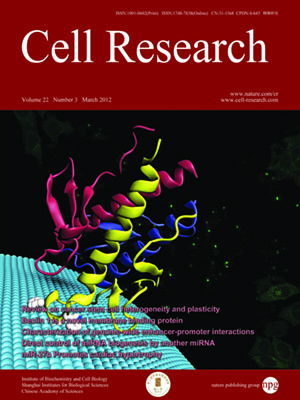
Volume 22, No 3, Mar 2012
ISSN: 1001-0602
EISSN: 1748-7838 2018
impact factor 17.848*
(Clarivate Analytics, 2019)
Volume 22 Issue 3, March 2012: 528-538
ORIGINAL ARTICLES
IL-17 response mediates acute lung injury induced by the 2009 Pandemic Influenza A (H1N1) Virus
Chenggang Li1,*, Penghui Yang2,*, Yang Sun1,*, Taisheng Li3,*, Chen Wang4,*, Zhong Wang5,*, Zhen Zou1, Yiwu Yan1, Wei Wang1, Chen Wang1, Zho
1State Key Laboratory of Medical Molecular Biology, Institute of Basic Medical Sciences, Chinese Academy of Medical Sciences, Center of Translational Medicine, Peking Union Medical College, Tsinghua University, Beijing 100005, China
2State Key Laboratory of Pathogens and Biosecurity, Beijing Institute of Microbiology and Epidemiology, Beijing 100071, China
3Department of Infectious Diseases, Peking Union Medical College Hospital, Chinese Academy of Medical Sciences & Peking Union Medical College, Beijing 100730, China
4Beijing Chao-Yang Hospital, Beijing Institute of Respiratory Medicine, Capital Medical University, Beijing 100020, China
5Emergency Department, Peking Union Medical College Hospital, Chinese Academy of Medical Sciences & Peking Union Medical College, Beijing 100730, China
6State Key Laboratory of Medicinal Chemical Biology, College of Life Sciences, Nankai University, Tianjin 300071, China<
Correspondence: Chengyu Jiang, Xiliang Wang,(jiang@pumc.edu.cn; xiliangw@126.com)
The 2009 flu pandemic involved the emergence of a new strain of a swine-origin H1N1 influenza virus (S-OIV H1N1) that infected almost every country in the world. Most infections resulted in respiratory illness and some severe cases resulted in acute lung injury. In this report, we are the first to describe a mouse model of S-OIV virus infection with acute lung injury and immune responses that reflect human clinical disease. The clinical efficacy of the antiviral oseltamivir (Tamiflu) administered in the early stages of S-OIV H1N1 infection was confirmed in the mouse model. Moreover, elevated levels of IL-17, Th-17 mediators and IL-17-responsive cytokines were found in serum samples of S-OIV-infected patients in Beijing. IL-17 deficiency or treatment with monoclonal antibodies against IL-17-ameliorated acute lung injury induced by the S-OIV H1N1 virus in mice. These results suggest that IL-17 plays an important role in S-OIV-induced acute lung injury and that monoclonal antibodies against IL-17 could be useful as a potential therapeutic remedy for future S-OIV H1N1 pandemics.
Cell Research (2012) 22:528-538. doi:10.1038/cr.2011.165; published online 25 October 2011
FULL TEXT | PDF
Browse 2197


